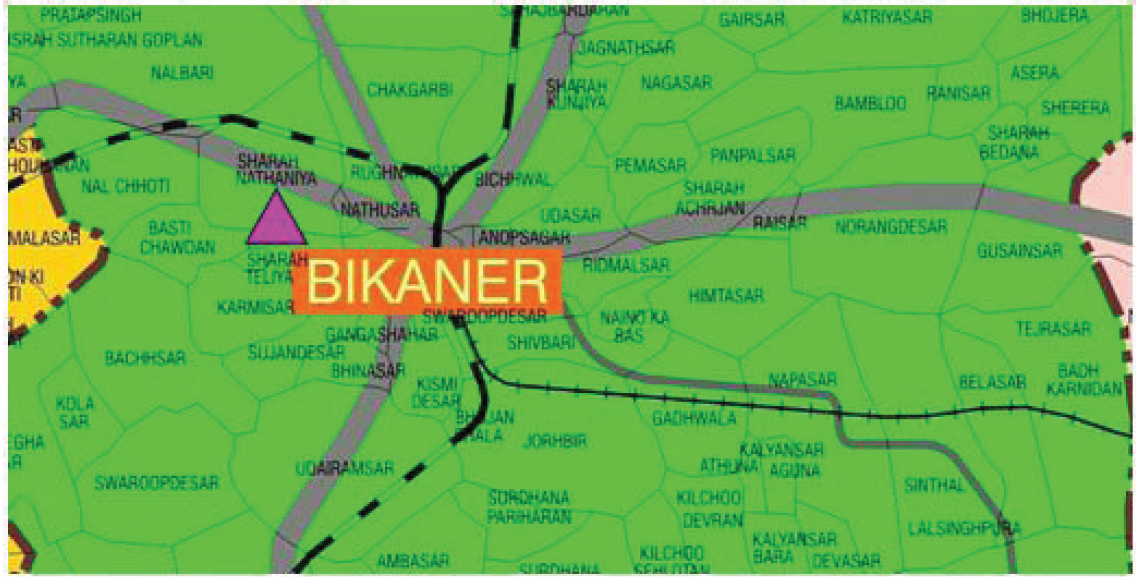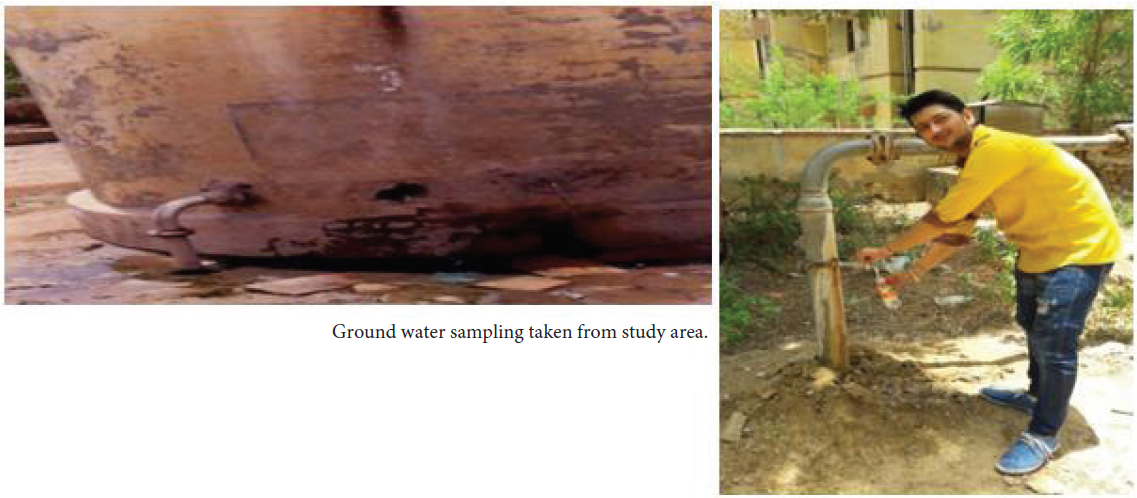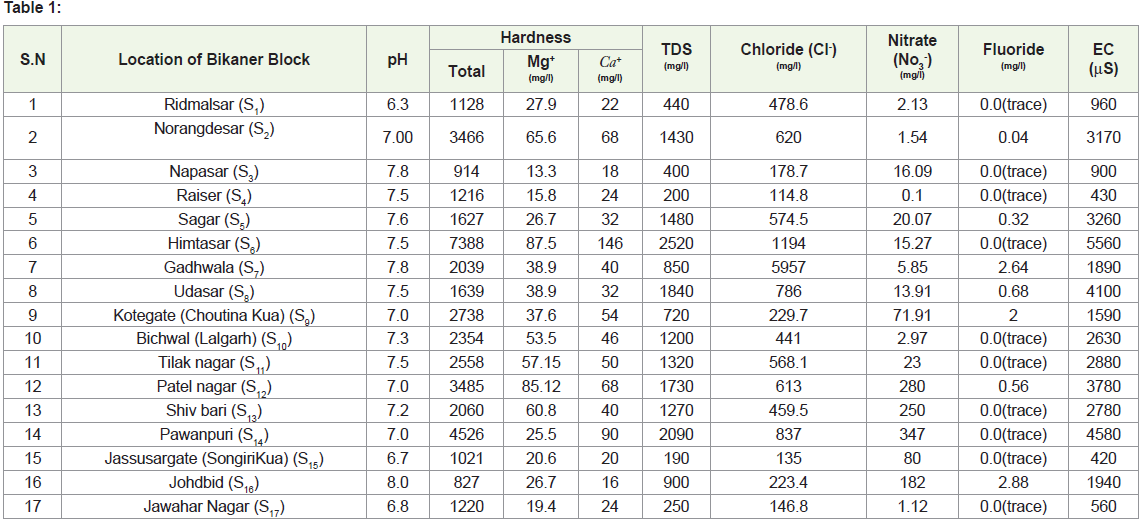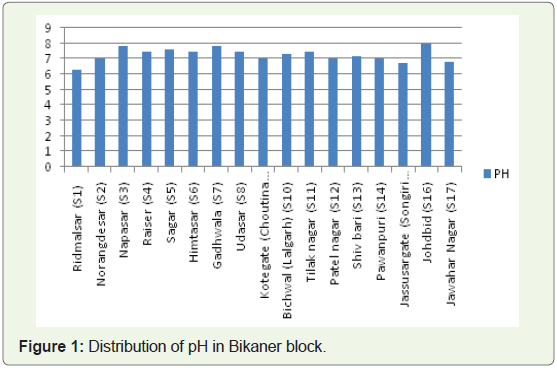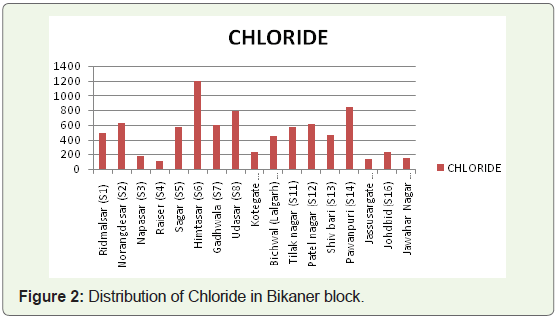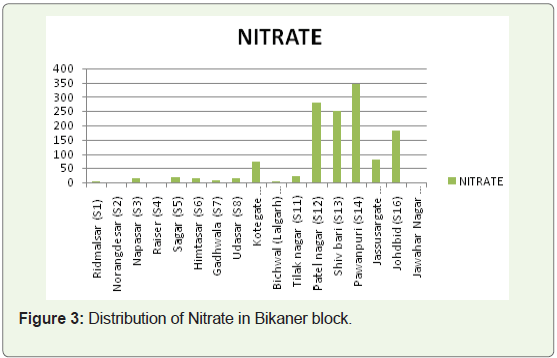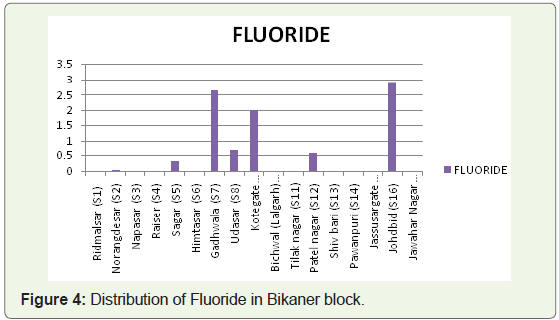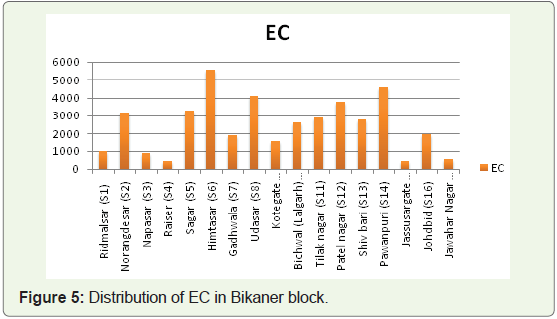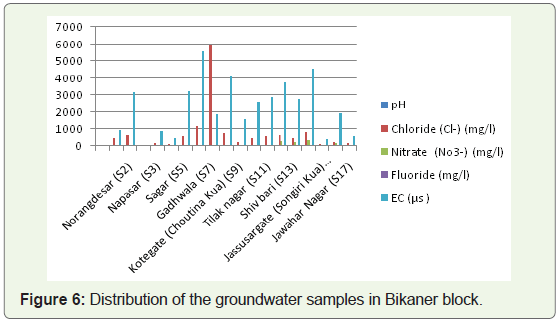Research Article
An Investigation of Physicochemical Quality of Groundwater Source of Bikaner Block: a Case Study
Dular AK* and Godara P
Department of Environmental Science, Maharaja Ganga Singh University, Bikaner (Rajasthan), India
*Corresponding author: Dular AK, Department of Environmental Science, Maharaja Ganga Singh University, Bikaner
(Rajasthan), India; Tel: 0135-2721763; E-mail: dular_ak@rediffmail.com
Article Information: Submission: 08/10/2022; Accepted: 16/11/2022; Published: 21/11/2022
Copyright: © 2022 Dular AK, et al. This is an open access article distributed under the Creative Commons Attribution
License, which permits unrestricted use, distribution, and reproduction in any medium, provided the original work is
properly cited.
Abstract
The provision of safe supply of drinking water is a high priority issue to a government for safe guarding the health of human beings. The production and
supply of adequate and safe drinking water is the most important factor contributing to a decrease in morbidity and mortality in developing country like India.
As we know water is a very good solvent, hence some toxic and hazardous substance dissolves in it and produce water pollution problem posing many
parameters of interest for water quality assessment. In Rajasthan 71% of the irrigation and 90% of the drinking water supply sources are under ground water
(Rathore 2005).Water quality index is one of the most effective tools to communicate information on the quality of water to the concerned citizen and policy
makers. It thus, becomes an important parameter for the assessment and management of ground water. In absence of surface water resources, people
of the area primarily depend upon underground water to meet out their drinking and agricultural requirements. The underground water in the study area is
characterized by medium to high salinity. More than 57% water is of sodium chloride type and distributed throughout the district. The district is notorious for
having high fluoride and nitrate concentration in underground water [1], which makes it unsuitable for drinking purpose. The dry climate condition with high
evaporation and insignificant recharge might have accelerated the strengthening of fluoride and nitrate concentration in the underground water of this area.
Keywords
Physicochemical quality; Ground water source; Sampling method
About the Study Area
Bikaner block is located in the North-western part of Rajasthan
and encompassed between North Latitudes 27º11’ to 29º03’ and East
Longitudes 71º52’ to 74º15’ covering geographical area of 30247.90
km. The block experiences arid type of climate. The Mean annual
rainfall (1971- 2005) of the district is 297.7 mm. whereas normal
rainfall(1901-1971) is lower than average rainfall and placed at 257.8
mm. Almost 90% of the total annual rainfall is received during the
Southwest monsoon, which enters the block in the first week of
July and withdraws in the mid of September. As the block lies in
the desert area, extreme of heat in summer and cold in winter is the
characteristic of the desert. The temperature varies from 48 degree
in summer to 1 degree in winter. Atmosphere is generally dry except during the monsoon period. The humidity is highest in august with
mean daily relative humidity is 71% in the morning and 52% in the
evening. The soils of Bikaner block area predominantly light textured,
weak- structured but well-drained.
Materials & Methods
In present study of discourse total 17 ground water sample were
collected from tube-wells, open wells and Hand pumps of different
locations were analyzed for estimation of physical and chemical
properties like PH, total Hardness, Ca+2, TDS, chloride, EC, Nitrate
and fluoride, sample were collected clean bottles of 1 litre [2].
The physicochemical characteristics of the ground water sample
determined by Standard method in 2002. The PH, TDS was measured by using portable meters and manual method. The concentrations of
magnesium, calcium, hardness were estimated by volumetric method
and total hardness of water was estimated by complex metric titration
with EDTA, chlorides content here determined volumetrically by
AgNo3 titrimetric method. Other parameters like F- and No3
- were
estimated by Spectrophotometric method. The results are comparable
with WHO and BIS water standards [3,4].
The 17 Sample collected from different villages/sites of different
regions of Bikaner block in district Bikaner are namely.1 Ridmalsar
(S1)2. Norangdesar (S2)3. Napasar (S3)4. Raisar (S4)5. Sagar (S5)6.
Himtasar (S6)7. Gadhwala (S7)8. Udasar (S8)9. Kotegate (Choutina
Kua) (S9)10. Bichwal (Lalgarh) (S10)11. Tilak nagar (S11)12. Patel nagar
(S12)13. Shiv bari (S13)14. Pawanpuri (S14)15. Jassusargate (SongiriKua)
(S15)16. Johdbid (S16)17 [5]. Jawahar Nagar (S17) following parameters
were studied as per prescribed method pertaining to the discourses
in study area like pH is most important in determining the corrosive
nature of water. Lower the pH value higher is the corrosive nature
of water. pH was positively correlated with electrical conductance
and total alkalinity the reduced rate of photosynthetic activity the
assimilation of carbon dioxide and bicarbonates which are ultimately
responsible for increase in pH, the low oxygen values coincide with
high temperature during the summer month. Various factors bring about changes the pH of water. The higher pH values observed
suggests that carbon-dioxide; carbonate-bicarbonate equilibrium
is affected more due to changes in physico-chemical condition. The
parameter like conductivity (specific conductance) is the numerical
expression of the water’s ability to conduct an electric current.
It is measured in micro Siemens per cm and depends on the total
concentration, mobility, valence and the temperature of the solution
of ions. Electrolytes in a solution disassociate into positive (cations)
and negative (anions) ions and impart conductivity. Most dissolved
inorganic substances are in the ionised form in water and contribute
to conductance. The conductance of the samples gives rapid and
practical estimate of the variation in dissolved mineral content of
the water supply. Conductance is defined as the reciprocal of the
resistance involved and expressed as mho or Siemen (s). The presence
of chlorides in natural waters can mainly be attributed to dissolution
of salt deposits in the form of ions (Cl-) [8]. Otherwise, high
concentrations may indicate pollution by sewage, industrial wastes,
intrusion of seawater or other saline water. It is the major form of
inorganic anions in water for aquatic life. High chloride content
has a deleterious effect on metallic pipes and structures, as well as
agricultural plants. They are calculated by Argento- metric method.
Total Dissolved Solid is calculated by conductivity cell done with
standard KCL solution. It is based on the principle of wheat-stone
bridge. The unknown resistance can be calculated. Its reciprocal gives
us the conductance [9,10].
Total Hardness estimated in accordance to select a sample
volume that requires less than 15ml EDTA titrate and complete
titration with in 5 min., measured from time of buffer addition. Take
50ml well mixed sample in a conical flask. Add 1-2ml buffer solution
followed by 1ml inhibitor usually 1-2ml buffer solution is sufficient to
give of pH of 10.Add a pinch of Erichrome black-T and titrate with
standard EDTA (0.01) till wine red color change to blue.
The confinement of Fluoride estimatation as it has dual
significance in water supplies. High concentration causes dental
fluorosis and lower concentration (<0.8 mg/L) causes dental caries.
A fluoride concentration of approximately 1mg/L in drinking water
is recommended. They are frequently found in certain industrial
processes resulting in fluoride rich wastewaters. Significant sources
of fluoride are found in coke, glass and ceramic, electronics, pesticide
and fertiliser manufacturing, steel and aluminium processing and
electroplating industries. It is calculated by SPADNS method [11-15].
Results
The following observations have been made as per recommended
methods of studied parameters in study area (Table 1 & Figure 1-6).
Discussion
The data revealed that pH ranged from shows that 6.3 to 8, the
minimum pH was observed in Ridmalsar village (S1) and maximum
pH was detected in Jodbid (S16) [16,17]. According to BIS standard,
least and ideal pH value for human consumption is 7.0, but it may
vary from 6.5 to 8.5 thus, the entire sample tested very slightly
Alkaline. The pH of all samples was within limit the pH value above
7.0 shows the alkaline nature of water due to excess of carbonate and biocarbonates. It is the important parameter for the use of
water. The water with a high TDS value Indicates that water is highly
mineralized. The Desirable limit for TDS 500 Mg/l and maximum
limit is 2000mg/l. Prescribed for drinking purpose according to
BIS. The Concentration of TDS in the present. Study is observed in
the range of 190mg/l to 2520mg/l. It is showed that sample S6 and
S14 are unsuitable for drinking and irrigation purpose as the TDS
is more than 2000mg/l in these samples. - The concentration of chloride varied between 114.8 to 837 mg/l. The minimum value was
observed in Raisar (S4) and maximum concentration in Pawanpuri
(S14). However according to BIS the permissible limit for chloride is
250-1000 mg/l, Which indicate that the drinking water of location
contained chloride, concentration within permissible limit except
for Pawanpuri (S14).Where in the chloride concentration ishigher
than the permissible limit. High concentration of Cl- produces
hypertension, effect metabolism of the body and increase the electrical
conductivity of water. Present study shows the concentration of Ca is
between 16 to 146 mg/l. The minimum value was observed in Jorbir
(S16) and maximum concentration in the Himtasar (S6) all sample is
permissible limit. Magnesium value in the studied area varies between
13.3 to 87.5 mg/l. The maximum value was recorded in the Himtasar
(S6) & minimum value was observed in Napasar (S3). According to
BIS standards Magnesium permissible limit is 30-100 thus, the all
sample were within limit.- The hardness of water produced by the
ca+2 and Mg+2 salt. The bicarbonate sulphates and chlorides. Hardness
value in the studied area varied between 827 to 7388 mg/l. Excess
hardness cause stomach disorder and finally weakens the stomach
permanently. The nitrate content in water source of present study
area ranged from 0.1 to 347 mg/l. the minimum value was observed
in Raisar (S4) & maximum concentration in Pawanpuri (S14). Sample
S9, S12, S13, S14, S15, S16, shows higher level of nitrate in drinking water
which is beyond permissible limit. According to BIS permissible limit
of nitrate in water is 45 mg/1-100mg/l. So this water is not good for
health. Nitrate in ground water is originated from fertilizers, septic
system and manure spreading operations. Nitrate is one of the
most frequent ground water pollutions in rural area it needs to be
regulated in drinking water basically. The toxicity of No3
-ion is due
to its reduction in No2
- ion in the human body. No2
- oxidized normal
hemoglobin to me hemoglobin. Which is unable to transport oxygen
to the tissue? This condition is called methenoglobinema (blue
baby disease) causes cyanosis and at higher concentration asphyxia.
According to BIS standard the limit of fluoride is 1.0 to 1.5 mg/l.
The fluoride content in water sources of present study area ranged
from0.0 trace to 2.88 mg/l at S1, S2, S3, S4, S6, S10, S11, S13, S14, S15, S17
& maximum value (S16) respectively. Three samples (S7), (S9), (S16),
have fluoride more than the permissible limit. So it is not suitable for
drinking purpose and its leads to various health hazards line dental
and skeletal fluorosis, the people of study area also complained of
joint and abdominal pain. The fluoride concentration is between 0.9
to 1.2 mg/l. than dental fluorosis is started and fluoride exceeds the
level of 3 mg/l. than skeletal fluorosis is started in living beings [18-21].
Conclusion
The Quality of ground water of Bikaner block and surrounding
area is not according to norms of Rajasthan government and WHO
standards higher concentration to there at this salt had deleterious
effect on the human health [5]. Higher concentration of nitrates had
been found to be associated with cancer in Slovakia [6]. Knobetoch
(2000) reported blue baby syndrome associated with high nitrate
concentration in water [7]. Neal et al. (2000) analyzed the water
quality of Thames tributaries and found to be contaminated by
anthropogenic activities Akhilesh et al. (2005) carried out study on
the geochemical scenario of fluoride in the whole Rajasthan [1].
The pH results indicate that ground water of Bikaner block is highly
brackish to saline in nature. The total hardness of ground water of
this area falls in the hard category. Total hardness, chloride, nitrates
and fluoride properties of drinking water in the study area indicate
the sign of deterioration which calls for at least primary treatment
of ground water before being used for drinking. During sample
collection people of area also complained about diarrhea, gastric
and other digestion related problems, which may be because of
consuming ground water containing high amount of nitrate contents.
Consumption of high concentration of fluoride was resulted in bone
deformity and joint pains. Laanthe et al. (2002) has suggested some
bioremediation methods of nitrate but these have yet to gain fruitful
results [9]. The purpose to persuade present research work was to
know ground water quality and to find out chemical and biochemical
remediation of problematic ions. The Study suggests that regular
evaluation of water quality needed in Bikaner block so that strategies
can be developed to reduce excess chemical contaminations and the
water can made suitable for drinking purposes.

